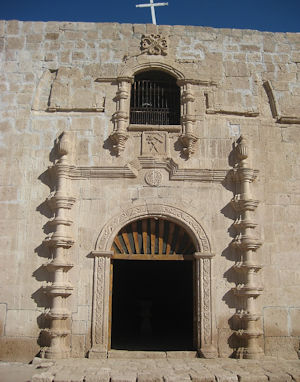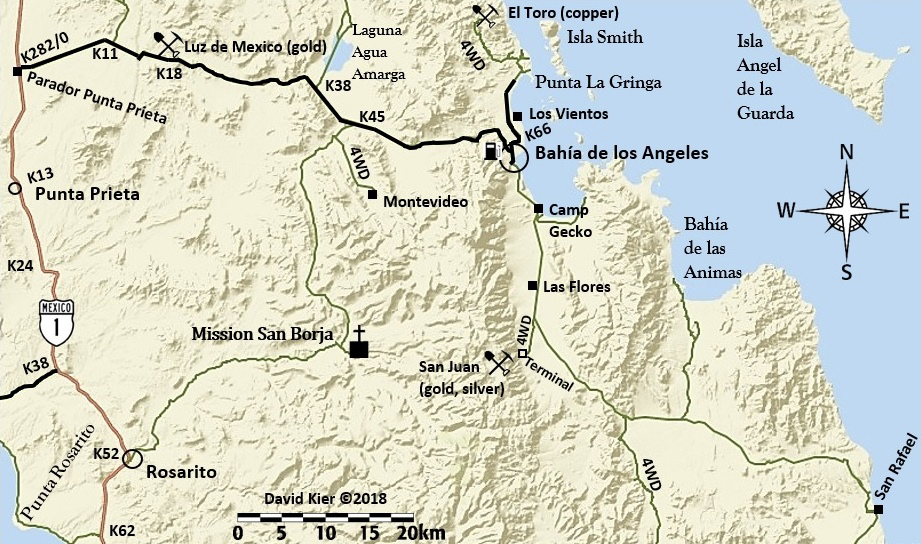 |  |
By David Kier

In the center of the peninsula, between the Transpeninsular Highway and Bahía de los Ángeles is a most magnificent structure in a seemingly alien landscape. The structure is the cut-stone church of Mission San Francisco de Borja Adac (‘San Borja’ for short). The church was built by the Dominican missionaries for Spain, beginning after 1773 and up until 1801 when the project was halted. Before the stone church and other rooms were erected, a large adobe complex was constructed by the Jesuits, some even before this mission was officially founded in 1762. The Franciscans built an even larger adobe complex during their five years on the peninsula from 1768 to 1773. Those adobe ruins are behind the stone church and are partially protected by a steel awning which was erected eighteen years ago.
There are two ways to drive to San Borja and that provides for a loop trip through the site, so the same road need not be traveled twice. The West Road, from Highway One, begins in the small town of (Nuevo) Rosarito at Km. 52 and goes 21 miles to the mission.
 The North Road begins on the Bahía de los Ángeles highway at Km. 45 (13 miles from Bahía de los Ángeles) and runs 21 miles to the mission. The road is graded and is occasionally re-scraped. When traveled in 2017, neither road required four-wheel-drive but the occasional ruts and rocks in the roadbed dictated the use of a truck or an SUV (no motorhomes). The north road was an easier drive of the two.
The North Road begins on the Bahía de los Ángeles highway at Km. 45 (13 miles from Bahía de los Ángeles) and runs 21 miles to the mission. The road is graded and is occasionally re-scraped. When traveled in 2017, neither road required four-wheel-drive but the occasional ruts and rocks in the roadbed dictated the use of a truck or an SUV (no motorhomes). The north road was an easier drive of the two.
The desert vegetation along the San Borja road is some of the finest examples of Baja California’s native desert plants. The camera will be busy if you are looking for photo opportunities! The Montevideo ancient painted cliff site is off the north road and about six miles in. The road was very sandy and not advisable without four-wheel-drive. Montevideo is a cliff-art location that can be driven right to, making it an excellent experience for children and senior citizens to enjoy with minimal walking required.
The El Camino Real mission road from Loreto to San Diego and on to Monterey follows or is over-laid by the north road for a few miles. To see exactly the trail location, on satellite maps, use this new website created after many years of research and hiking the desert of Baja California: El Camino Real in Baja California (note the map points H6-H8 & H42-H46).
Starting at Rosarito, the road leaves Highway 1 at Km. 52 southbound or Km. 52.5 northbound. Both roads are signed, and they meet in the small village where the road goes east for San Borja. In 15 miles is Rancho San Ignacito at a small oasis where the Jesuits established a visita (mission visiting station) then called San Ignacio.
 San Borja had at least eight visitas which were satellite mission outposts. Rosarito was also one, but back then, it was called El Rosario. At Mile 17.8 from Highway 1 is the signed road to Rancho San Gregorio (El Canto de la Tierra, an eco-resort).
San Borja had at least eight visitas which were satellite mission outposts. Rosarito was also one, but back then, it was called El Rosario. At Mile 17.8 from Highway 1 is the signed road to Rancho San Gregorio (El Canto de la Tierra, an eco-resort).
Mile 20.3 is a fork and the right branch goes 0.9 mile to the mission and the palapa campground. The palapa camping spots offer shade, showers, and flush toilets for a very reasonable price of 150 pesos per person. A path goes from the palapas past the fields to the hot spring of Adac, which was the primary water source for the mission. Another spring is located east of the adobe ruins, but its flow is seasonal.
One family lives at San Borja; Meet José and Analisia Gerardo. They have several adult children who may be there also to help provide tours of the mission, hot springs, or arrange trips to rock art sites. They work for tips. José’s brother had also arrived to help build a cantina in 2017. Camping in the many palapas offers a place to relax and not be rushed to see the magnificent site. José has a small ‘museum’ of artifacts from the Indians, the mission, and the old San Juan mines.
Going north from San Borja, it is 21.4 miles to the Bahía de los Ángeles highway. 17.2 miles from the mission is a fork. Either branch may be taken as they come back together in just under 1 mile. The left fork goes by Rancho Agua de Higuera and a spring of bubbling sulfur water.


About David
David Kier is a veteran Baja traveler, author of 'Baja California - Land Of Missions' and co-author of 'The Old Missions of Baja and Alta California 1697-1834'. Visit the Old Missions website.

Every time I go to south of the border I get coverage with Baja Bound, it’s so easy to do on line...

Good seevice have use baja bound for many years good price....

If you are going to Mexico Baja Bound is excellent. Buy online, good price, good quality. Fast and...